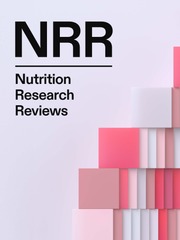Crossref Citations
This article has been cited by the following publications. This list is generated based on data provided by
Crossref.
Younger, K. M.
2009.
Editorial.
Nutrition Research Reviews,
Vol. 22,
Issue. 1,
p.
1.
Chaves Neto, Antonio Hernandes
Yano, Claudia Lumy
Paredes-Gamero, Edgar Julian
Machado, Daisy
Justo, Giselle Zenker
Peppelenbosch, Maikel P.
and
Ferreira, Carmen Veríssima
2010.
Riboflavin and photoproducts in MC3T3-E1 differentiation.
Toxicology in Vitro,
Vol. 24,
Issue. 7,
p.
1911.
Wynn, E.
Krieg, M. A.
Lanham-New, S. A.
and
Burckhardt, P.
2010.
Postgraduate Symposium Positive influence of nutritional alkalinity on bone health.
Proceedings of the Nutrition Society,
Vol. 69,
Issue. 1,
p.
166.
Hamidi, M.
Boucher, B. A.
Cheung, A. M.
Beyene, J.
and
Shah, P. S.
2011.
Fruit and vegetable intake and bone health in women aged 45 years and over: a systematic review.
Osteoporosis International,
Vol. 22,
Issue. 6,
p.
1681.
Mattila, Pirjo H.
Hellström, Jarkko
McDougall, Gordon
Dobson, Gary
Pihlava, Juha-Matti
Tiirikka, Timo
Stewart, Derek
and
Karjalainen, Reijo
2011.
Polyphenol and vitamin C contents in European commercial blackcurrant juice products.
Food Chemistry,
Vol. 127,
Issue. 3,
p.
1216.
Feghali, Karine
Feldman, Mark
La, Vu Dang
Santos, Juliana
and
Grenier, Daniel
2012.
Cranberry Proanthocyanidins: Natural Weapons against Periodontal Diseases.
Journal of Agricultural and Food Chemistry,
Vol. 60,
Issue. 23,
p.
5728.
Veprik, Anna
Khanin, Marina
Linnewiel-Hermoni, Karin
Danilenko, Michael
Levy, Joseph
and
Sharoni, Yoav
2012.
Polyphenols, isothiocyanates, and carotenoid derivatives enhance estrogenic activity in bone cells but inhibit it in breast cancer cells.
American Journal of Physiology-Endocrinology and Metabolism,
Vol. 303,
Issue. 7,
p.
E815.
Seidlova-Wuttke, Dana
Stecher, Günther
Kammann, Markus
Haunschild, Jutta
Eder, Nicole
Stahnke, Vera
Wessels, Johannes
and
Wuttke, Wolfgang
2012.
Osteoprotective effects of Cimicifuga racemosa and its triterpene-saponins are responsible for reduction of bone marrow fat.
Phytomedicine,
Vol. 19,
Issue. 10,
p.
855.
Hapidin, Hermizi
Abdullah, Hasmah
and
Nirwana Soelaiman, Ima
2012.
The Potential Role of Quercus Infectoria Gall Extract on Osteoblast Function and Bone Metabolism.
Open Journal of Endocrine and Metabolic Diseases,
Vol. 02,
Issue. 04,
p.
82.
Combs, Gerald F.
2012.
The Vitamins.
p.
395.
Hayatullina, Zil
Muhammad, Norliza
Mohamed, Norazlina
and
Soelaiman, Ima-Nirwana
2012.
Virgin Coconut Oil Supplementation Prevents Bone Loss in Osteoporosis Rat Model.
Evidence-Based Complementary and Alternative Medicine,
Vol. 2012,
Issue. ,
p.
1.
Gunn, Caroline A.
Weber, Janet L.
Coad, Jane
and
Kruger, Marlena C.
2013.
Increasing fruits and vegetables in midlife women: a feasibility study.
Nutrition Research,
Vol. 33,
Issue. 7,
p.
543.
Gunn, Caroline A
Weber, Janet L
and
Kruger, Marlena C
2013.
Midlife women, bone health, vegetables, herbs and fruit study. The Scarborough Fair study protocol.
BMC Public Health,
Vol. 13,
Issue. 1,
Cancalon, Paul F.
2013.
Bioactives in Fruit.
p.
101.
Chen, Jin-Ran
Lazarenko, Oxana P
Zhang, Jian
Blackburn, Michael L
Ronis, Martin JJ
and
Badger, Thomas M
2014.
Diet-Derived Phenolic Acids Regulate Osteoblast and Adipocyte Lineage Commitment and Differentiation in Young Mice.
Journal of Bone and Mineral Research,
Vol. 29,
Issue. 5,
p.
1043.
Marissal-Arvy, Nathalie
Batandier, Cécile
Dallennes, Julien
Canini, Frédéric
Poulet, Laurent
Couturier, Karine
Hininger-Favier, Isabelle
Moisan, Marie-Pierre
Roussel, Anne-Marie
and
Mormède, Pierre
2014.
Effect of a high-fat–high-fructose diet, stress and cinnamon on central expression of genes related to immune system, hypothalamic–pituitary–adrenocortical axis function and cerebral plasticity in rats.
British Journal of Nutrition,
Vol. 111,
Issue. 7,
p.
1190.
García-Martínez, Olga
Rivas, Ana
Ramos-Torrecillas, Javier
De Luna-Bertos, Elvira
and
Ruiz, Concepción
2014.
The effect of olive oil on osteoporosis prevention.
International Journal of Food Sciences and Nutrition,
Vol. 65,
Issue. 7,
p.
834.
Léotoing, Laurent
Davicco, Marie-Jeanne
Lebecque, Patrice
Wittrant, Yohann
and
Coxam, Véronique
2014.
The flavonoid fisetin promotes osteoblasts differentiation through Runx2 transcriptional activity.
Molecular Nutrition & Food Research,
Vol. 58,
Issue. 6,
p.
1239.
Hubert, Patrice
Lee, Sang
Lee, Sun-Kyeong
and
Chun, Ock
2014.
Dietary Polyphenols, Berries, and Age-Related Bone Loss: A Review Based on Human, Animal, and Cell Studies.
Antioxidants,
Vol. 3,
Issue. 1,
p.
144.
Rao, L.G.
Kang, N.N.
and
Rao, A.V.
2014.
Aging.
p.
247.

